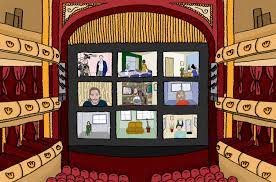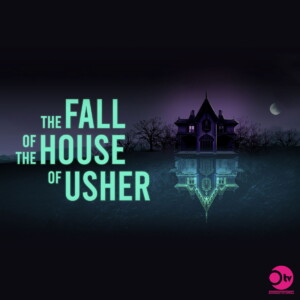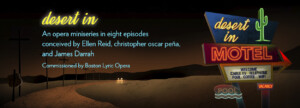In 2020, the COVID-19 pandemic changed the world as we knew it. New guidelines for public life were put in place, impacting every corner of our society. Doors closed, programs were canceled, gatherings were banned, and the arts sector was all but decimated. We found ourselves pondering: how can the arts survive if we are not allowed to perform, and our audience is not permitted to watch?
Yet, seemingly overnight, a virtual world rapidly developed and became the new normal. Companies, artists, and everyone really, dove headfirst into cyberspace and started innovating. Suddenly, our daily activities became available online, including work, school, recreation, socialization, healthcare, and worship services, to name a few. We became physically isolated yet globally interconnected more than ever before. We began to attend conferences, panel discussions, rehearsals, and performances online. Although fully virtual productions were uncharted territory for most, artists and art organizations picked up the mantle and began adapting to the virtual stage, paving the way for the arts to become accessible in entirely new ways.
 Before the pandemic, the ability to attend a live performance was largely restricted by geography. That is to say, you could only experience the magic of an opera if you could travel to the theater (a movie theater, in the case of the Met in HD). Now, arts organizations have completely reimagined their programming and offer many, if not all, events and performances online. “Moving [events] online has allowed institutions to expand their reach to audiences well beyond their physical location and create new ways of sharing art and culture with a broader community,” Laura Reed, a Zoom reporter, writes.
Before the pandemic, the ability to attend a live performance was largely restricted by geography. That is to say, you could only experience the magic of an opera if you could travel to the theater (a movie theater, in the case of the Met in HD). Now, arts organizations have completely reimagined their programming and offer many, if not all, events and performances online. “Moving [events] online has allowed institutions to expand their reach to audiences well beyond their physical location and create new ways of sharing art and culture with a broader community,” Laura Reed, a Zoom reporter, writes.
 Boston Lyric Opera quickly shifted its 2020/21 Season online and has been innovative in adapting opera to the virtual stage, becoming one of the first companies to produce a fully animated opera available for streaming. The Fall of the House of Usher premiered in January 2021, to positive reception from viewers in 26 countries around the world. In addition to reaching a larger geographic audience, opera performances available digitally have a much larger, if not unlimited, capacity for viewership. Usher is available to stream for a full year, with new viewers signing in to watch each week. The final number of viewers is likely to surpass what BLO could have achieved in a physical theater space, which usually only runs for a few days.
Boston Lyric Opera quickly shifted its 2020/21 Season online and has been innovative in adapting opera to the virtual stage, becoming one of the first companies to produce a fully animated opera available for streaming. The Fall of the House of Usher premiered in January 2021, to positive reception from viewers in 26 countries around the world. In addition to reaching a larger geographic audience, opera performances available digitally have a much larger, if not unlimited, capacity for viewership. Usher is available to stream for a full year, with new viewers signing in to watch each week. The final number of viewers is likely to surpass what BLO could have achieved in a physical theater space, which usually only runs for a few days.
Not only has shifting to online programming increased the capacity for widespread viewership, but has also lifted a financial barrier for some. Purchasing a ticket to attend a live performance in a theater costs anywhere between $25 to upwards of a few hundred dollars. Add parking, transportation, and perhaps dinner out, and it soon becomes an expensive evening. The fee for patrons to view a streaming production, like The Fall of the House of Usher, is $10 and can be watched on demand, anytime, from the comfort of home. Additionally, many opera companies are now streaming past opera performances for free, removing finance from the equation altogether.
The ability to watch performances from home in a flexible timeframe has also increased accessibility. An opera is often one to three hours long and runs only for a short number of performances before it closes. While some virtual programming is livestreamed, most performances are available for viewing on demand, so patrons can enjoy an opera performance on a day and time that is most convenient for them—even watching in installments, or multiple times in succession.
While the pandemic changed opera as we knew it, transitioning to a virtual landscape has also created opportunities for innovation and collaboration. Many companies turned to streaming previous performances to still provide opera to their patrons. Others have created brand new digital content that has expanded the ways we can engage with this beautiful art form.
 BLO has commissioned a new work, desert in, that is groundbreaking for opera in concept, format, and production process. This opera is a digital limited series format with eight episodes, each composed and written by a different composer and librettist. BLO filmed parts of the production on location, recorded other pieces remotely, and is constructing a final digital product that showcases the collaboration of nearly 100 professionals, many of whom have never met face to face. This is merely one example of how opera companies across the globe are adapting their productions to this new virtual performing arts world.
BLO has commissioned a new work, desert in, that is groundbreaking for opera in concept, format, and production process. This opera is a digital limited series format with eight episodes, each composed and written by a different composer and librettist. BLO filmed parts of the production on location, recorded other pieces remotely, and is constructing a final digital product that showcases the collaboration of nearly 100 professionals, many of whom have never met face to face. This is merely one example of how opera companies across the globe are adapting their productions to this new virtual performing arts world.
 Beyond performances, other events have also been adapted to reach virtual audiences including courses, panel discussions, and conferences. Convenings that were once held at a specific time and place are now available to anyone with time, equipment, and internet connection. This has increased opportunities to share knowledge and resources, have important conversations, and gather to learn from professionals, organizations, and community leaders. Arts and cultural organizations, educational institutions, and others have hosted events designed specifically to engage with current cultural and social issues as they relate to the arts, such as BLO’s “We Need to Listen” panel discussion series hosted by Celeste Headlee that brought scholars and artists together on Zoom to discuss racial equity in the opera industry. Hosting these events online has given scholars, leaders, and changemakers from around the world the opportunity to convene and impact widespread audiences.
Beyond performances, other events have also been adapted to reach virtual audiences including courses, panel discussions, and conferences. Convenings that were once held at a specific time and place are now available to anyone with time, equipment, and internet connection. This has increased opportunities to share knowledge and resources, have important conversations, and gather to learn from professionals, organizations, and community leaders. Arts and cultural organizations, educational institutions, and others have hosted events designed specifically to engage with current cultural and social issues as they relate to the arts, such as BLO’s “We Need to Listen” panel discussion series hosted by Celeste Headlee that brought scholars and artists together on Zoom to discuss racial equity in the opera industry. Hosting these events online has given scholars, leaders, and changemakers from around the world the opportunity to convene and impact widespread audiences.
In many ways, “going virtual” has increased access to the arts, particularly in relation to location, cost, and time. However, the global shift to all virtual programming has also presented unique challenges to accessibility. Not all households have stable internet connections and there are often distractions at home that can make focus difficult. Additionally, participating on video can give others the ability to see your personal living space, which may be uncomfortable or feel invasive to some. Engaging fully online can also be challenging, particularly because of what is referred to as screen fatigue, since a majority of our day-to-day lives are spent on screen.
It is also important to consider how adapting to a virtual space has impacted artists. When COVID-19 shuttered theaters, many artists dove into the virtual sphere where they were required to adapt to a new digital medium. Performing arts professionals—actors, musicians, and dancers—are trained to work in a highly collaborative way: communicating through subtle cues, improvising simultaneously, and playing off the energy of the audience. For virtual performances, artists must now pre-record their part in isolation, eliminating the possibility for spontaneous collaboration. Technical difficulties or lack of proper equipment can obstruct an artist’s performance, causing both frustration and a fractured performance experience. These arts professionals must also perform for an audience that they can no longer see, hear, or sense; it is as if they are merely performing for themselves in a mirror. This is all to say that the experience of a performer is entirely different in a virtual space than in a live venue.
The lack of face-to-face connection not only impacts the performers, but also the audience. Many people are drawn to live performances to experience a moment together, one which is raw, organic, and unique each time. Not only are these moments more challenging for artists to create, but fostering the same sense of community online can present its own challenges. Nothing compares to sitting in a theater and being immersed in magnificent music, gasping and laughing with fellow audience members, or contributing to the deafening eruption of simultaneous applause as the audience gives a standing ovation. It begs the question, are virtual performances merely a different version of performing arts, or are they a different art form altogether?
It is hard to say if the increased prevalence of online performing arts experiences has improved access to the arts overall. It seems more like “going virtual” has simply changed the ways in which the arts can be accessible, and yet, there are still challenges to overcome. We must wonder, however, what will happen when we have the option to perform in theaters again? When programming can be held safely in person, will there be enough compelling reasons to continue with virtual engagement as well?
The arts help facilitate and celebrate the ways we connect through the telling and sharing of stories, and the ways we gather and live in communities. However, our institutions have traditionally excluded some of our community from these opportunities, perhaps inadvertently, making participation prohibitive for them. Moving online has created “an opportunity realize different people [engage in] different ways and there’s a huge population of people that have been othered or ignored or just ‘forgotten about’ [who can be more involved now],” teaching artist, Jason Jedrusiak, says. These new ways of connecting have opened up opportunities for artists and organizations to collaborate and innovate to reach broader audiences.
If post-pandemic, artists, creators, educators, and community members have the option to choose their preferred format, virtual or hybrid programs may become even more effective than they are now. “I think a lot of great things are going to come from this, from the people who have found that it works for them,” said Lydia Jane Graeff, a local actor and BLO Resident Teaching Artist.
There are still many unknowns as to what the future will look like, yet it is clear that the world will never be the same. Throughout the pandemic, the arts have grown and changed—opera has grown and changed. Many barriers were removed only to be met by new ones, highlighting that accessibility to the arts is constantly changing. If we have learned anything in this time, it is that there are endless possibilities in reaching our communities, despite hurdles that stand in our way. Now that we have discovered new methods for innovation, creation, and community engagement, it seems clear that artists and arts organizations will continue working toward creative solutions to be inclusive of all those who would like to engage in this ever-evolving over 400-year-old art form we love.
—
Dassi Lipnick is the Education Intern for Boston Lyric Opera and a graduate student at Lesley University, currently earning her M.Ed. in Community Arts Education. She is a musician and artist who strives to make arts education accessible in her community. Dassi would like to thank all those who she interviewed during the research of this piece, including BLO staff Rebecca Kirk, Sara O’Brien, and teaching artists Lydia Jane Graeff and Jason Jedrusiak.
In the Frame:
Feature image courtesy of nytimes.com. Art by Sofia Probert.
A logo for The Fall of the House of Usher on operabox.tv. Design by Myung-Hee Cho and Melissa Wagner O’Malley.
A logo for desert in on operabox.tv. Design by Myung-Hee Cho and Melissa Wagner O’Malley.
A logo for We Need to Listen on operabox.tv. Design by Melissa Wagner O’Malley.

